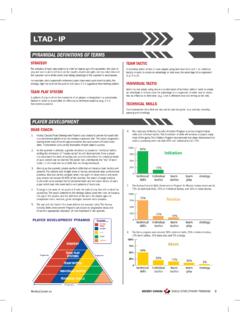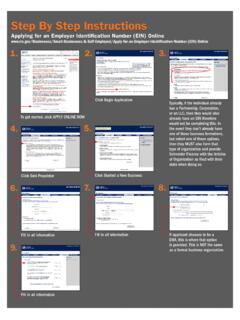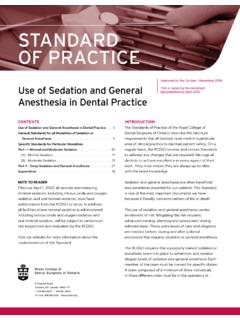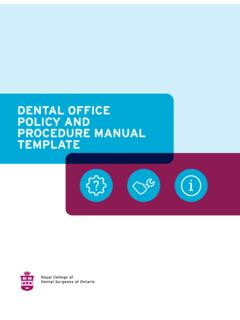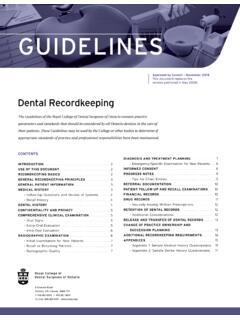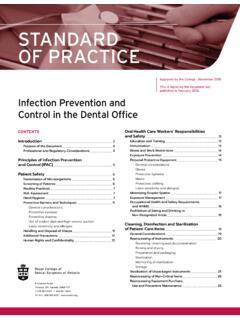Transcription of PACCAR MX-13 Engine Operator's Manual - Y53-1181-1A1
1 Contents Safety Emergency Controls Driving Maintenance Information 1 2 3 4 5 6 7 Index Contents 2012 PACCAR Inc - All Rights Reserved This Manual illustrates and describes the operation of features or equipment which may be either standard or optional on this vehicle. This Manual may also include a description of features and equipment which are no longer available or were not ordered on this vehicle. Please disregard any illustrations or descriptions relating to features or equipment which are not on this vehicle. PACCAR reserves the right to discontinue, change specifications, or change the design of its vehicles at any time without notice and without incurring any obligation. The information contained in this Manual is proprietary to PACCAR . Reproduction, in whole or in part, by any means is strictly prohibited without prior written authorization from PACCAR Inc. 1 Safety Introduction Safety Alerts.. 1-3 Foreword .. 1-5 Important Reference Number .. 1-6 Illustrations.
2 1-7 General Safety Instructions.. 1-7 1-1 Introduction Introduction WARNING 1 Safety Alerts Please read and follow all of the safety alerts contained in this Manual . They are there for your protection and information. These alerts can help you avoid injury to yourself, your passengers, and help prevent costly damage to the vehicle. Safety alerts are highlighted by safety alert symbols and signal words such as "WARNING", "CAUTION", or "NOTE". Please do not ignore any of these alerts. WARNING! The safety alert following this symbol and signal word provides a warning against operating procedures which could cause death or injury. They could also cause equipment or property damage. The alert will identify the hazard, how to avoid it, and the probable consequence of not avoiding the hazard. Example: WARNING! Do not carry additional fuel contain-ers in your vehicle. Fuel containers, either full or empty, may leak, ex-plode, and cause or feed a fire. Do not carry extra fuel containers.
3 Even empty ones are dangerous. Failure to comply may result in death, per-sonal injury, equipment or property damage. 1-3 Introduction 1 CAUTION NOTE NOTE CAUTION The safety alert following this symbol and signal word provides a caution against operating procedures which could cause equipment or property damage. The alert will identify the hazard, how to avoid it, and the probable consequence of not avoiding the hazard. Example: Continuing to operate your vehi-cle with insufficient oil pressure will cause serious Engine damage. Fail-ure to comply may result in equip-ment or property damage. CAUTION The alert following this symbol and signal word provides important information that is not safety related but should be followed. The alert will highlight things that may not be obvious and is useful to your efficient operation of the vehicle. Example: NOTE Pumping the accelerator will not as-sist in starting the Engine . 1-4 Foreword This Manual contains information for the correct operation and maintenance of your PACCAR Engine .
4 Read and follow all safety instructions. Refer to the WARNING in the General Safety Instructions beginning on page 1-7. Keep this Manual with the equipment. If the equipment is traded or sold, give the Manual to the new owner. The information, specifications, and recommended maintenance guidelines in this Manual are based on information in effect at the time of printing. PACCAR reserves the right to make changes at any time without obligation. If you find differences between your Engine and the information in this Manual , contact your local PACCAR Authorized Repair Location or write to PACCAR c/o PACCAR Engines, PO Box 1518, Bellevue, WA 98009. The latest technology and the highest quality components were used to produce this Engine . When replacement parts are needed, we recommend using only genuine parts from PACCAR . Introduction 1 1-5 1 Introduction Important Reference Number Fill in the part name and number in the blank spaces provided below. This will give you a reference whenever service or maintenance is required.
5 Part Name Number Engine Model Engine Serial Number (ESN) Oil Type (Use API CJ-4 oil only) Filter Part Numbers: Air Cleaner Element Lubricating Oil Fuel (Use ultra -low sulfur diesel fuel only) Coolant Belt Part Numbers: 1-6 Introduction 1 Illustrations General Information Some of the illustrations throughout this Manual are generic and will not look exactly like the Engine or parts used in your application. The illustrations are intended to show repair or replacement procedures. The procedure will be the same for all applications, although the illustration can differ. General Safety InstructionsImportant Safety Notice WARNING! Improper practices, carelessness, or ignoring any warnings may cause death, personal injury, equipment or property damage. Before performing any repair, read and understand all of the safety precautions and warnings. The following is a list of general safety precautions that must be followed to provide personal safety. Failure to follow these instructions may cause death or injury.
6 Special safety precautions are included in the procedures when they apply. Use the proper tool for manually rotating the Engine . Do not attempt to rotate the crankshaft by pulling or prying on the fan. This practice can cause death, personal injury, equipment damage, or damage to the fan blades, causing premature fan failure. Work areas should be dry, well lit, ventilated, free from clutter, loose tools, parts, ignition sources and hazardous substances. Wear protective glasses and protective shoes when working. Do not wear loose-fitting or torn clothing. Remove all jewelry when working. Before beginning any repair, disconnect the battery (negative [-] cable) and discharge any capacitors. Put a "DO NOT OPERATE" tag in the Operator's compartment or on the controls. Allow the Engine to cool before slowly loosening the coolant filler cap to relieve the pressure from the cooling system. 1-7 1 Introduction Always use blocks or proper stands to support the vehicle or vehicle components before performing any service work.
7 Do not work on anything that is supported only by lifting jacks or a hoist. Before removing or disconnecting any lines, fittings, or related items, relieve all pressure in the air, oil, fuel, and cooling systems. Remain alert for possible pressure when disconnecting any device from a system that contains pressure. High pressure oil or fuel can cause death or personal injury. Always wear protective clothing when working on any refrigerant lines and make sure that the workplace is in a well ventilated area. Inhalation of fumes can cause death or personal injury. To protect the environment, liquid refrigerant systems must be properly emptied and filled using equipment that prevents the release of refrigerant gas. Federal law requires capturing and recycling refrigerant. When moving or lifting any heavy equipment or parts, make sure to use proper techniques and assistance. Ensure all lifting devices such as chains, hooks, or slings are in good condition and are of the correct load capacity.
8 Make sure any lifting devices are positioned correctly. Corrosion inhibitors and lubricating oils may contain alkali. Do not get the substance in eyes and avoid prolonged or repeated contact with skin. Do not swallow. In case of contact, immediately wash skin with soap and water. In case of harmful contact, immediately contact a physician. Always keep any chemicals OUT OF REACH OF CHILDREN. Naptha and Methyl Ethyl Ketone (MEK) are flammable materials and must be used with caution. Follow the manufacturer's instructions to ensure safety when using these materials. Always keep any chemicals OUT OF REACH OF CHILDREN. When working on the vehicle, be alert for hot parts on systems that have just been turned off, exhaust gas flow, and hot fluids in lines, tubes, and compartments. Contact with any hot surface may cause burns. Always use tools that are in good condition. Make sure you have the proper understanding of how to use the tools before performing any service work.
9 Use only genuine replacement parts from PACCAR . 1-8 Introduction 1 Always use the same fastener part number (or equivalent) when replacing items. Do not use a fastener of lesser quality if replacements are necessary. Do not perform any repair when impaired, tired, fatigued or after consuming alcohol or drugs that can impair your functioning. Some state and federal agencies in the United States of America have determined that used Engine oil can be carcinogenic and can cause reproductive toxicity. Avoid inhalation of vapors, ingestion, and prolonged contact with used Engine oil. Coolant is toxic. If not reused, dispose of coolant in accordance with local environmental regulations. California Proposition 65 Warning - diesel Engine exhaust and some of its constituents are known to the State of California to cause cancer, birth defects, and other reproductive harm. The catalyst substrate located in the diesel Particulate Filter contains Vanadium Pentoxide. Vanadium Pentoxide has been determined by the State of California to cause cancer.
10 Always wear protective clothing and eye protection when handling the catalyst assembly. Dispose of the catalyst in accordance with local regulations. If catalyst material gets into the eyes, immediately flood eyes with water for a minimum of 15 minutes. Avoid prolonged contact with skin. In case of contact, immediately wash skin with soap and water. In case of harmful contact, immediately contact a physician. CAUTION Corrosive chemicals can damage the Engine . Do not use corrosive chemicals on the Engine . Failure to comply may result in equipment or property damage. 1-9 EMERGENCY WHAT TO DO You Need Roadside Assistance.. 2-3 Stop Engine Lamp Turns On .. 2-3 Engine Oil Pressure Lamp Turns On.. 2-4 Check Engine Lamp Turns On .. 2-5 Engine is Overheating.. 2-5 2 2-1 WHAT TO DO WHAT TO DO You Need Roadside Assistance Call toll-FREE to talk to someone at the PACCAR Customer Center: Kenworth customers, call 1-800-KW-ASSIST (1-800-592-7747). Peterbilt customers, call 1-800-4-PETERBILT (1-800-473-8372).
